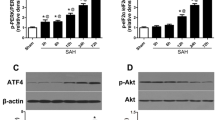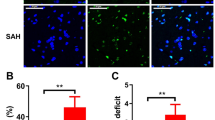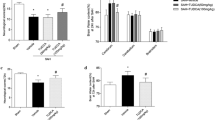Abstract
Neuronal apoptosis is a potentially fatal pathological process that occurs in early brain injury (EBI) after subarachnoid hemorrhage (SAH). There is an urgent need to identify effective therapeutics to alleviate neuronal apoptosis. Tetramethylpyrazine (TMP), as an important component of the Chinese traditional medicinal herb Ligusticum wallichii, has been widely used in China to treat cerebral ischemic injury and confer neuroprotection. In the present work, we investigate whether TMP can reduce EBI following SAH in rats, specifically via inactivating the PERK/Akt signaling cascade. One hundred twenty-five male Sprague–Dawley rats were used in the present study. TMP was administered by intravenous (i.v.) injection, and the Akt inhibitor MK2206 was injected intracerebroventricularly (i.c.v.). SAH grade, neurological scores, and brain water content were measured 24 h after SAH. Neuronal apoptosis was visualized by Fluoro-Jade C (FJC) staining. Western blotting was used to measure the levels of PERK, p-PERK, eIF2α, p-eIF2α, Akt, p-Akt, Bcl-2, Bax, and cleaved caspase-3. Our results showed that TMP effectively reduced neuronal apoptosis and improved neurobehavioral deficits 24 h after SAH. Administration of TMP reduced the abundance of p-PERK and p-eIF2α. In addition, TMP increased the p-Akt level and the Bcl-2/Bax ratio and decreased the level of cleaved caspase-3. The selective Akt inhibitor MK2206 abolished the anti-apoptotic effect of TMP at 24 h after SAH. Collectively, these results indicate that Akt-related anti-apoptosis through the PERK pathway is a major, potent mechanism of EBI. Further investigation of this pathway may provide a basis for the development of TMP as a clinical treatment.








Similar content being viewed by others
References
Lawton MT, Vates GE (2017) Subarachnoid hemorrhage. N Engl J Med 377(3):257–266. https://doi.org/10.1056/NEJMcp1605827
Chen S, Feng H, Sherchan P, Klebe D, Zhao G, Sun X, Zhang J, Tang J, Zhang JH (2014) Controversies and evolving new mechanisms in subarachnoid hemorrhage. Prog Neurobiol 115:64–91. https://doi.org/10.1016/j.pneurobio.2013.09.002
Yan F, Cao S, Li J, Dixon B, Yu X, Chen J, Gu C, Lin W, Chen G (2017) Pharmacological inhibition of PERK attenuates early brain injury after subarachnoid hemorrhage in rats through the activation of Akt. Mol Neurobiol 54(3):1808–1817. https://doi.org/10.1007/s12035-016-9790-9
Chen S, Wu H, Tang J, Zhang J, Zhang JH (2015) Neurovascular events after subarachnoid hemorrhage: focusing on subcellular organelles. Acta Neurochir Suppl 120:39–46. https://doi.org/10.1007/978-3-319-04981-6_7
Zhao J, Xiang X, Zhang H, Jiang D, Liang Y, Qing W, Liu L, Zhao Q, He Z (2017) CHOP induces apoptosis by affecting brain iron metabolism in rats with subarachnoid hemorrhage. Exp Neurol 302:22–33. https://doi.org/10.1016/j.expneurol.2017.12.015
Zhu X, Wang K, Zhang K, Tan X, Wu Z, Sun S, Zhou F, Zhu L (2015) Tetramethylpyrazine protects retinal capillary endothelial cells (TR-iBRB2) against IL-1beta-induced nitrative/oxidative stress. Int J Mol Sci 16(9):21775–21790. https://doi.org/10.3390/ijms160921775
Gao C, Liu X, Liu W, Shi H, Zhao Z, Chen H, Zhao S (2008) Anti-apoptotic and neuroprotective effects of Tetramethylpyrazine following subarachnoid hemorrhage in rats. Autonomic Neurosci 141(1–2):22–30. https://doi.org/10.1016/j.autneu.2008.04.007
Shao Z, Li J, Zhao Z, Gao C, Sun Z, Liu X (2010) Effects of tetramethylpyrazine on nitric oxide/cGMP signaling after cerebral vasospasm in rabbits. Brain Res 1361:67–75. https://doi.org/10.1016/j.brainres.2010.09.011
Liu W, Liu K, Zhang S, Shan L, Tang J (2018) Tetramethylpyrazine showed therapeutic effects on sepsis-induced acute lung injury in rats by inhibiting endoplasmic reticulum stress protein kinase RNA-like endoplasmic reticulum kinase (PERK) signaling-induced apoptosis of pulmonary microvascular endothelial cells. Med Sci Monit 24:1225–1231
Sun X, Liao W, Wang J, Wang P, Gao H, Wang M, Xu C, Zhong Y, Ding Y (2016) CSTMP induces apoptosis and mitochondrial dysfunction in human myeloma RPMI8226 cells via CHOP-dependent endoplasmic reticulum stress. Biomed Pharmacother 83:776–784. https://doi.org/10.1016/j.biopha.2016.07.045
Wu P, Li Y, Zhu S, Wang C, Dai J, Zhang G, Zheng B, Xu S, Wang L, Zhang T, Zhou P, Zhang JH, Shi H (2017) Mdivi-1 alleviates early brain injury after experimental subarachnoid hemorrhage in rats, possibly via inhibition of Drp1-activated mitochondrial fission and oxidative stress. Neurochem Res 42(5):1449–1458. https://doi.org/10.1007/s11064-017-2201-4
Sugawara T, Ayer R, Jadhav V, Zhang JH (2008) A new grading system evaluating bleeding scale in filament perforation subarachnoid hemorrhage rat model. J Neurosci Methods 167(2):327–334. https://doi.org/10.1016/j.jneumeth.2007.08.004
Garcia JH, Wagner S, Liu KF, Hu XJ (1995) Neurological deficit and extent of neuronal necrosis attributable to middle cerebral artery occlusion in rats. Statistical validation. Stroke 26(4):627–634; discussion 635
Chen S, Ma Q, Krafft PR, Chen Y, Tang J, Zhang J, Zhang JH (2013) P2 × 7 receptor antagonism inhibits p38 mitogen-activated protein kinase activation and ameliorates neuronal apoptosis after subarachnoid hemorrhage in rats. Crit Care Med 41(12):e466–e474. https://doi.org/10.1097/CCM.0b013e31829a8246
Wang R, Ma WG, Gao GD, Mao QX, Zheng J, Sun LZ, Liu YL (2011) Fluoro jade-C staining in the assessment of brain injury after deep hypothermia circulatory arrest. Brain Res 1372:127–132. https://doi.org/10.1016/j.brainres.2010.11.059
Zhao Y, Liu Y, Chen K (2016) Mechanisms and clinical application of tetramethylpyrazine (an interesting natural compound isolated from Ligusticum wallichii): current status and perspective. Oxidative Med Cell Longev 2016:2124638. https://doi.org/10.1155/2016/2124638
Zhang G, Zhang F, Zhang T, Gu J, Li C, Sun Y, Yu P, Zhang Z, Wang Y (2016) Tetramethylpyrazine nitrone improves neurobehavioral functions and confers neuroprotection on rats with traumatic brain injury. Neurochem Res 41(11):2948–2957. https://doi.org/10.1007/s11064-016-2013-y
Hu J, Lang Y, Cao Y, Zhang T, Lu H (2015) The neuroprotective effect of tetramethylpyrazine against contusive spinal cord injury by activating PGC-1alpha in rats. Neurochem Res 40(7):1393–1401. https://doi.org/10.1007/s11064-015-1606-1
Zhang C, Teng F, Tu J, Zhang D (2014) Ultrasound-enhanced protective effect of tetramethylpyrazine against cerebral ischemia/reperfusion injury. PLoS One 9(11):e113673. https://doi.org/10.1371/journal.pone.0113673
Lu C, Zhang J, Shi X, Miao S, Bi L, Zhang S, Yang Q, Zhou X, Zhang M, Xie Y, Miao Q, Wang S (2014) Neuroprotective effects of tetramethylpyrazine against dopaminergic neuron injury in a rat model of Parkinson’s disease induced by MPTP. Int J Biol Sci 10(4):350–357. https://doi.org/10.7150/ijbs.8366
Rasheva VI, Domingos PM (2009) Cellular responses to endoplasmic reticulum stress and apoptosis. Apoptosis 14(8):996–1007. https://doi.org/10.1007/s10495-009-0341-y
Roussel BD, Kruppa AJ, Miranda E, Crowther DC, Lomas DA, Marciniak SJ (2013) Endoplasmic reticulum dysfunction in neurological disease. Lancet Neurol 12(1):105–118. https://doi.org/10.1016/S1474-4422(12)70238-7
Goswami P, Gupta S, Biswas J, Sharma S, Singh S (2016) Endoplasmic reticulum stress instigates the rotenone induced oxidative apoptotic neuronal death: a study in rat brain. Mol Neurobiol 53(8):5384–5400. https://doi.org/10.1007/s12035-015-9463-0
Li H, Yu JS, Zhang HS, Yang YQ, Huang LT, Zhang DD, Hang CH (2016) Increased expression of caspase-12 after experimental subarachnoid hemorrhage. Neurochem Res 41(12):3407–3416. https://doi.org/10.1007/s11064-016-2076-9
Gharibani P, Modi J, Menzie J, Alexandrescu A, Ma Z, Tao R, Prentice H, Wu JY (2015) Comparison between single and combined post-treatment with S-Methyl-N,N-diethylthiolcarbamate sulfoxide and taurine following transient focal cerebral ischemia in rat brain. Neuroscience 300:460–473. https://doi.org/10.1016/j.neuroscience.2015.05.042
Rubovitch V, Barak S, Rachmany L, Goldstein RB, Zilberstein Y, Pick CG (2015) The neuroprotective effect of salubrinal in a mouse model of traumatic brain injury. Neuromol Med 17(1):58–70. https://doi.org/10.1007/s12017-015-8340-3
Moreno JA, Halliday M, Molloy C, Radford H, Verity N, Axten JM, Ortori CA, Willis AE, Fischer PM, Barrett DA, Mallucci GR (2013) Oral treatment targeting the unfolded protein response prevents neurodegeneration and clinical disease in prion-infected mice. Sci Translational Med 5(206):206ra138. https://doi.org/10.1126/scitranslmed.3006767
Xie Z, Enkhjargal B, Wu L, Zhou K, Sun C, Hu X, Gospodarev V, Tang J, You C, Zhang JH (2018) Exendin-4 attenuates neuronal death via GLP-1R/PI3K/Akt pathway in early brain injury after subarachnoid hemorrhage in rats. Neuropharmacology 128:142–151. https://doi.org/10.1016/j.neuropharm.2017.09.040
Xu H, Li J, Wang Z, Feng M, Shen Y, Cao S, Li T, Peng Y, Fan L, Chen J, Gu C, Yan F, Wang L, Chen G (2017) Methylene blue attenuates neuroinflammation after subarachnoid hemorrhage in rats through the Akt/GSK-3beta/MEF2D signaling pathway. Brain Behav Immun 65:125–139. https://doi.org/10.1016/j.bbi.2017.04.020
Yan S, Chen L, Wei X, Cheng L, Kong L, Liu X, Zhang X, Liu H (2015) Tetramethylpyrazine analogue CXC195 ameliorates cerebral ischemia-reperfusion injury by regulating endothelial nitric oxide synthase phosphorylation via PI3K/Akt signaling. Neurochem Res 40(3):446–454. https://doi.org/10.1007/s11064-014-1485-x
Acknowledgements
This work was supported by a grant from the Youth Science Foundation of Heilongjiang Province (QC2014C102).
Author information
Authors and Affiliations
Corresponding author
Rights and permissions
About this article
Cite this article
Shao, Z., Wu, P., Wang, X. et al. Tetramethylpyrazine Protects Against Early Brain Injury and Inhibits the PERK/Akt Pathway in a Rat Model of Subarachnoid Hemorrhage. Neurochem Res 43, 1650–1659 (2018). https://doi.org/10.1007/s11064-018-2581-0
Received:
Revised:
Accepted:
Published:
Issue Date:
DOI: https://doi.org/10.1007/s11064-018-2581-0




